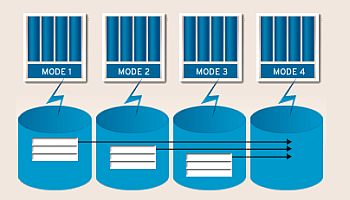HP Retunes Info Management Products And Services

HP offers start points for connecting silos of data, stopping short of the “master data management” label
Hewlett-Packard has updated both its products/service package and its marketing message for its information-management software and services.
Actually, there is no real talk of launching any new products, its more about the way the company is presenting its software and services to potential buyers – but the positioning of existing products in new and emerging markets is as important as anything else in this business.
Unifying Data Centre Product Marketing
 Aiming at connecting those hard-to-move, siloed data containers that are prevalent in so many IT systems, HP is unifying its data centre management products in an holistic approach to information management. The initiative now sits under the company’s new Instant-On Enterprise marketing umbrella.
Aiming at connecting those hard-to-move, siloed data containers that are prevalent in so many IT systems, HP is unifying its data centre management products in an holistic approach to information management. The initiative now sits under the company’s new Instant-On Enterprise marketing umbrella.
HP defines an Instant-On Enterprise as one that embeds business intelligence into everything it does to bring a transparent, real-time view of information across the organisation. This information is then made available to everybody in the value chain – to service customers, employees, partners, distributors and contractors – to get them what they need instantly.
Getting the silos, and the people who run them, to cooperate is the ideal, of course, but it is much all easier said than done. HP is stopping short of calling this a new way to do master data management. It turns out the company does not want that long-misunderstood image clouding its initiative.
Master data management, or MDM, is a set of processes and tools that consistently defines and manages the non-transactional data entities of an organisation – some of which may be reference data). MDM has the objective of providing processes for collecting, aggregating, matching, consolidating, quality-assuring, persisting and distributing such data throughout an organisation to ensure consistency and control in the ongoing maintenance and application use of this information.
The term is based on the concept of the old “master file” from days past. MDM is similar to virtual or federated database management.
HP, for almost any size enterprise, certainly has all the point products and services to fill in most of the blanks when it comes to IM. However, two respected IM product strategists told eWEEK that the company is not yet ready to come forth with a singular platform that can fill all the management gaps that IT systems might have.
“The proliferation of silos and differing hardware and software across enterprises is so vast, having been built up over a number of years in systems that work well enough, that there is no one-size-fits-all solution to all of this,” said Randy Kahn, who heads up a team of consultants at Kahn Consulting. Kahn addressed a small group of analysts and journalists at HP Pavilion.
“But for new companies and companies looking to refresh and modernise their systems, HP is a one-stop shop for getting all this done.”
Get Your ‘To-Do’ List Together
Brian Babineau, vice president of research and analyst services at Enterprise Strategy Group, said that the first thing enterprises need to do when looking at modernising a system is to “make a list, like those ‘honey do’-type lists. Figure out just one pain point to cure, do it and then move on to the next one. Don’t be overwhelmed by everything all at once. And it can be overwhelming.”
June Manley, worldwide product marketing director, HP Software, told the group that an overall strategy is of utmost importance in getting an older IT system up to speed to handle the upward spiralling influx of new data into storage, and that just installing a “master data management”-type platform is not necessarily the answer to all the demands that siloed big data brings.
“You really have to start with the people who own the data,” Manley said. “Who manages the info? Who’s in charge of the archives? E-discovery? Backup? And so on. Get these people together first, figure out a high-level strategy on how you want to proceed, then call in the outside help, and go from there.”
Here is a roundup of the new and/or updated products and services announced in the HP information management product group.
- HP Integrated Archive Platform (storage): This now scales to manage up to a petabyte of data, 300,000 users and 20 million email messages per day. It also now supports VMware vSphere for small to midsize enterprises.
- HP TRIM Enterprise Records Management has been enhanced with multi-jurisdictional retention, which automates retention schedules across multiple countries and within multinational enterprises. A new bulk data-loading capability reduces costs with faster throughput of bulk record updates.
- HP Database Archiving (storage) is now integrated with HP TRIM to give clients one platform for managing their structured information, as well as new connectivity to archive data from legacy systems during the application retirement process.
- HP Data Protector software (security) now provides granular recovery extension for VMware vSphere, as well as snapshot support for 3PAR and non-HP arrays. HP Data Protector also adds down-to-the-second snapshot recovery to HP StorageWorks P4000. Good news for storage administrators: No scripting required; it is all preconfigured.
- HP Data Protector Reporter (data backup) gives organisations better insight into their backup operations with enterprise-level, multisite global analysis and reporting.
- HP Storage Essentials software aims to improve alignment of storage capacity to business needs. Its Backup Manager plug-in for HP Data Protector helps monitor the entire backup process with a complete picture of the information state.
All the updates are available now, HP said.